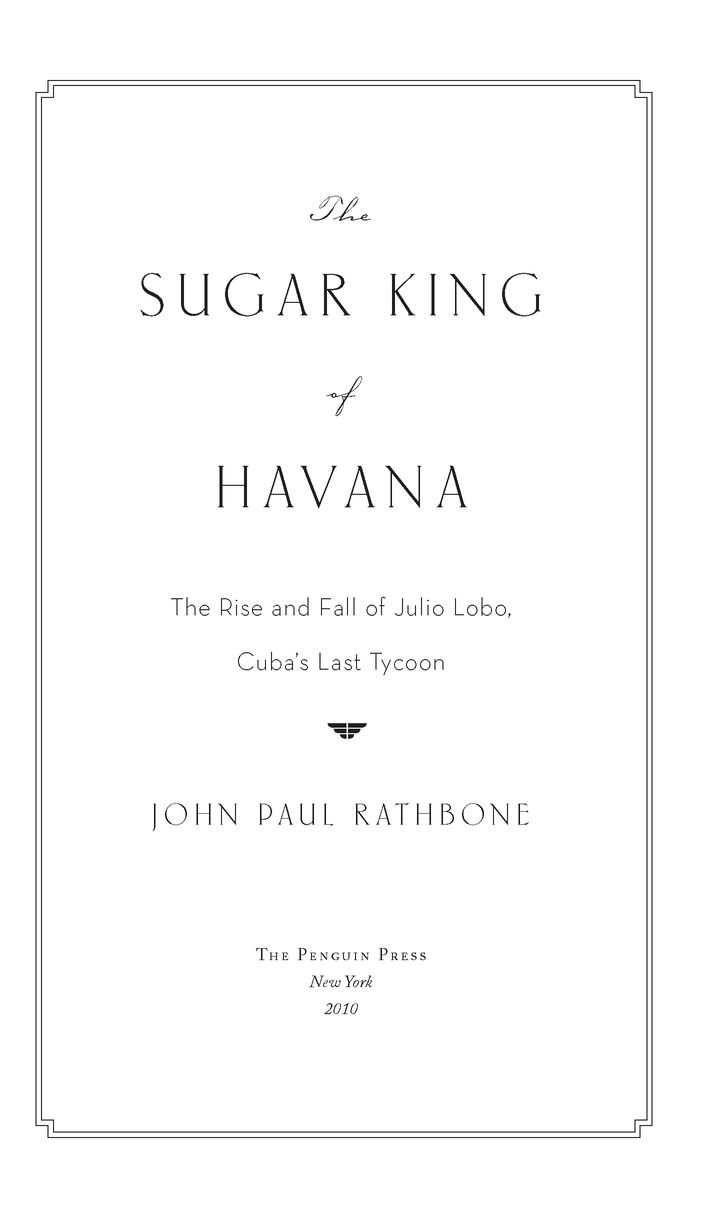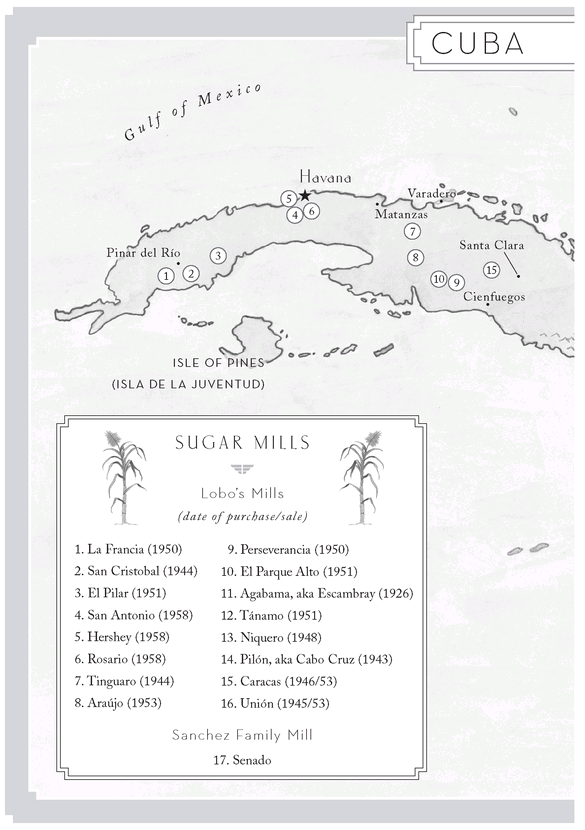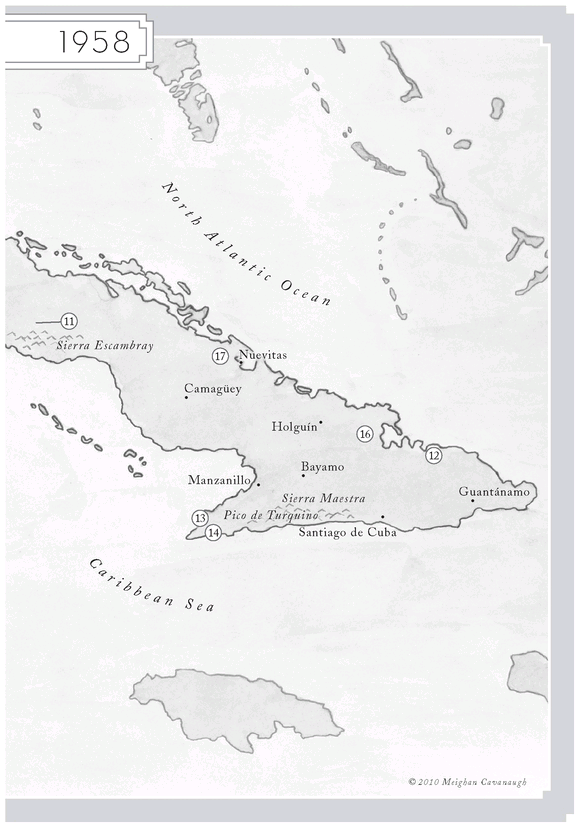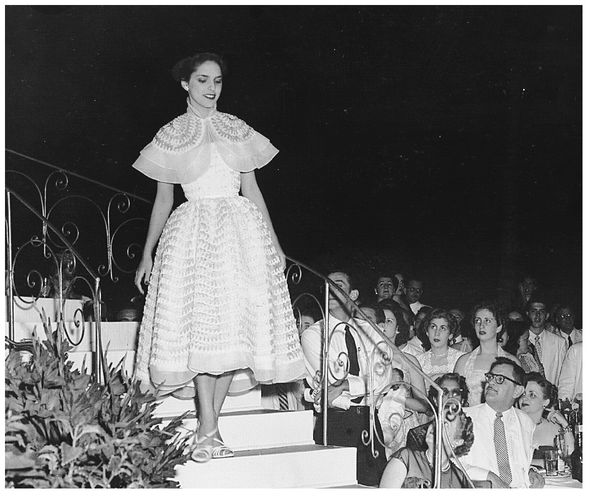The Sugar King of Havana
Read The Sugar King of Havana Online
Authors: John Paul Rathbone


Table of Contents

THE PENGUIN PRESS
Published by the Penguin Group
Penguin Group (USA) Inc., 375 Hudson Street, New York, New York 10014, U.S.A.
Penguin Group (Canada), 90 Eglinton Avenue East, Suite 700, Toronto, Ontario,
Canada M4P 2Y3 (a division of Pearson Penguin Canada Inc.) Penguin Books Ltd,
80 Strand, London WC2R 0RL, England Penguin Ireland, 25 St. Stephen’s Green,
Dublin 2, Ireland (a division of Penguin Books Ltd) Penguin Books Australia Ltd,
250 Camberwell Road, Camberwell, Victoria 3124, Australia (a division of Pearson
Australia Group Pty Ltd) Penguin Books India Pvt Ltd, 11 Community Centre,
Panchsheel Park, New Delhi–110 017, India Penguin Group (NZ), 67 Apollo
Drive, Rosedale, North Shore 0632, New Zealand (a division of Pearson
New Zealand Ltd) • Penguin Books (South Africa) (Pty) Ltd, 24 Sturdee Avenue,
Rosebank, Johannesburg 2196, South Africa
Published by the Penguin Group
Penguin Group (USA) Inc., 375 Hudson Street, New York, New York 10014, U.S.A.
Penguin Group (Canada), 90 Eglinton Avenue East, Suite 700, Toronto, Ontario,
Canada M4P 2Y3 (a division of Pearson Penguin Canada Inc.) Penguin Books Ltd,
80 Strand, London WC2R 0RL, England Penguin Ireland, 25 St. Stephen’s Green,
Dublin 2, Ireland (a division of Penguin Books Ltd) Penguin Books Australia Ltd,
250 Camberwell Road, Camberwell, Victoria 3124, Australia (a division of Pearson
Australia Group Pty Ltd) Penguin Books India Pvt Ltd, 11 Community Centre,
Panchsheel Park, New Delhi–110 017, India Penguin Group (NZ), 67 Apollo
Drive, Rosedale, North Shore 0632, New Zealand (a division of Pearson
New Zealand Ltd) • Penguin Books (South Africa) (Pty) Ltd, 24 Sturdee Avenue,
Rosebank, Johannesburg 2196, South Africa
Penguin Books Ltd, Registered Offices:
80 Strand, London WC2R 0RL, England
80 Strand, London WC2R 0RL, England
First published in 2010 by The Penguin Press,
a member of Penguin Group (USA) Inc.
a member of Penguin Group (USA) Inc.
All rights reserved
Excerpt from “Ogres and Pygmies” from
Collected Poems
by Robert Graves.
Used by permission of Carcanet Press Limited.
Collected Poems
by Robert Graves.
Used by permission of Carcanet Press Limited.
LIBRARY OF CONGRESS CATALOGING IN PUBLICATION DATA
Rathbone, John Paul.
The sugar king of Havana : the rise and fall of Julio Lobo, Cuba’s last tycoon / John
Paul Rathbone.
p. cm.
Includes bibliographical references and index.
Rathbone, John Paul.
The sugar king of Havana : the rise and fall of Julio Lobo, Cuba’s last tycoon / John
Paul Rathbone.
p. cm.
Includes bibliographical references and index.
eISBN : 978-1-101-45891-4
1. Lobo, Julio, 1898–2. Sugar trade—Cuba—History—20th century.
3. Businessmen—Cuba—Biography. 4. Cuba—History—1985–I. Title.
HD9114.C89L637 2010
338.7’63361092—dc22
[B] 2010013790
3. Businessmen—Cuba—Biography. 4. Cuba—History—1985–I. Title.
HD9114.C89L637 2010
338.7’63361092—dc22
[B] 2010013790
Without limiting the rights under copyright reserved above, no part of this publication may be reproduced, stored in or introduced into a retrieval system, or transmitted, in any form or by any means (electronic, mechanical, photocopying, recording or otherwise), without the prior written permission of both the copyright owner and the above publisher of this book.
The scanning, uploading, and distribution of this book via the Internet or via any other means without the permission of the publisher is illegal and punishable by law. Please purchase only authorized electronic editions and do not participate in or encourage electronic piracy of copyrightable materials. Your support of the author’s rights is appreciated.
To Lella
For Ruby and Mo


INTRODUCTION

C
uba has known many rich men since Christopher Columbus first introduced sugarcane to the island. At the start of the twentieth century, one Cuban sugar baron tiled the floors of his Havana palace with Italian marble bedded down in sand imported from the Nile. Tomás Terry, the most successful sugar planter of Cuba’s colonial years, left $25 million on his death in 1886—not bad considering that the then richest man in the world, William Backhouse Astor, left just $50 million. Yet Cuba does not have to look back more than a century to find extreme riches. In Havana today to have Croesus-like wealth is referred to as
ser rico como un Julio Lobo
—to be as rich as a Julio Lobo. After almost five decades of communism, Lobo’s fabled wealth has become folkloric, and he has become emblematic of a way of life that existed in Havana before the dictator Fulgencio Batista fled the island on New Year’s Eve 1958. Julio Lobo was the richest man in Cuba before Castro’s revolution did away with such men.
uba has known many rich men since Christopher Columbus first introduced sugarcane to the island. At the start of the twentieth century, one Cuban sugar baron tiled the floors of his Havana palace with Italian marble bedded down in sand imported from the Nile. Tomás Terry, the most successful sugar planter of Cuba’s colonial years, left $25 million on his death in 1886—not bad considering that the then richest man in the world, William Backhouse Astor, left just $50 million. Yet Cuba does not have to look back more than a century to find extreme riches. In Havana today to have Croesus-like wealth is referred to as
ser rico como un Julio Lobo
—to be as rich as a Julio Lobo. After almost five decades of communism, Lobo’s fabled wealth has become folkloric, and he has become emblematic of a way of life that existed in Havana before the dictator Fulgencio Batista fled the island on New Year’s Eve 1958. Julio Lobo was the richest man in Cuba before Castro’s revolution did away with such men.
Every Cuban schoolchild knows Columbus’s description of the island as being “more beautiful than any I have ever seen”; it is Cuba’s first exaggeration. Yet, like so many beautiful tropical places, the island has also suffered a commensurately cruel history. Lobo’s life frames and measures a poorly understood period of that history—the sixty-odd years of the prerevolutionary Cuban Republic. He was born in 1898, the year that Cuba won independence after thirty years of fighting against Spain, and he left the country in 1960, two years after Castro’s guerrillas came down from the hills. In his heyday, Lobo was known as the King of Sugar, not just of Havana but of the world, with an estimated personal fortune of $200 million, about $5 billion in today’s dollars. Yet he was also a financier of such talent that Castro’s government, which was Communist, asked Lobo, a full-blooded capitalist, to work for them after the revolution had begun. So Lobo captures the period’s contradictions too.
I had been fascinated by those elegant, decadent, and whirligig years all my life. The curiosity was an inevitable outgrowth of my mother’s exile. She was born in Havana and raised into a conventional upper-class Cuban world: her father owned a department store in the center of town; her grande dame mother presided over the home. Her haute bourgeoisie parents mingled in the same world as Lobo’s, and my mother was a close friend of his younger daughter. Years later, in England, when I was a child and couldn’t sleep, my mother would stroke my hair and murmur descriptions of her life in Cuba until I closed my eyes. The props for her stories of an almost dreamlike prerevolutionary life were the photograph albums that she kept on a bottom bookshelf in our living room in London. They had ragged brown leather spines, which creaked when you opened them. The stiff black pages inside were separated by tissue paper, which crackled as you turned them. Some of the photographs had slipped their bindings and stuck together. Then you could only glimpse croppings of a disappeared world: an empty table at a cocktail party, the back of someone’s head, a man’s ankle disappearing into a polished black shoe on a marble step. But most of the photographs had survived intact.
There she is in one faded polychrome, seventeen years old, beaming, dressed casually, sitting cross-legged on a wall, her loafers tucked under her shins. A later photograph, this time in black and white, shows her standing next to her first boyfriend. The handwritten caption underneath anticipates later boyfriends and later pages;
Victor y Yo
, Victor and I, soon becomes
Antonio y Yo
, and then
Walter y Yo
—the characteristic concerns of a Cuban debutante
.
One sequence of photographs shows her uncharacteristically demure in a white ball dress, walking down a spiral staircase at the Havana Country Club during a fashion gala. Turn the page, carefully, and there she is again, this time performing an elegant arabesque while ice-skating at Havana’s Blanquita Theater on First Avenue and Ninth Street, since renamed the Karl Marx Theater. Another shows her with a group of friends standing in the shallow end of a swimming pool, cocktails in their hands, all laughing. It looks like a scene of bourgeois American life in the 1950s, perhaps in Connecticut. Only it is a photograph of a swimming pool at one of Julio Lobo’s many estates outside Havana, where my mother sometimes stayed. It is also the same pool that Lobo supposedly filled with perfume so that Esther Williams, the Hollywood starlet of
Bathing Beauty
, could practice her swimming routines when she visited the island. Such are the legends from which revolutions are made, and then justified.
Victor y Yo
, Victor and I, soon becomes
Antonio y Yo
, and then
Walter y Yo
—the characteristic concerns of a Cuban debutante
.
One sequence of photographs shows her uncharacteristically demure in a white ball dress, walking down a spiral staircase at the Havana Country Club during a fashion gala. Turn the page, carefully, and there she is again, this time performing an elegant arabesque while ice-skating at Havana’s Blanquita Theater on First Avenue and Ninth Street, since renamed the Karl Marx Theater. Another shows her with a group of friends standing in the shallow end of a swimming pool, cocktails in their hands, all laughing. It looks like a scene of bourgeois American life in the 1950s, perhaps in Connecticut. Only it is a photograph of a swimming pool at one of Julio Lobo’s many estates outside Havana, where my mother sometimes stayed. It is also the same pool that Lobo supposedly filled with perfume so that Esther Williams, the Hollywood starlet of
Bathing Beauty
, could practice her swimming routines when she visited the island. Such are the legends from which revolutions are made, and then justified.

Other books
Ask Again Later by Jill A. Davis
Michael Asher by The Real Bravo Two Zero
Europa (Deadverse Book 1) by Flunker, Richard
The Worthing Saga by Orson Scott Card
Forever Never Ends by Scott Nicholson
Trail of Bones: A Young Adult Fantasy Novel by Chris Salisbury
Fury of the Demon (Kara Gillian) by Rowland, Diana
Heartsville 05 - Bloom Box (Cate Ashwood) by Heartsville
The Swan and the Jackal by J. A. Redmerski